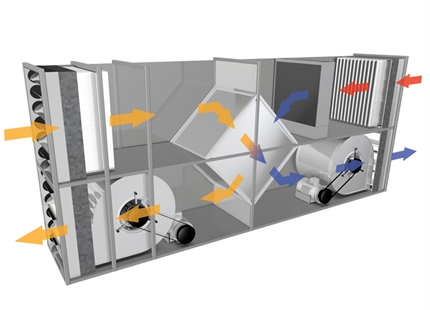
Author: David Gates, Area Sales Manager, Condair plc
Humidifiers de-mystified for the AC contractor
With a wide range of humidifiers on the market and an increased requirement by end users to reduce energy costs and CO2 emissions, what are the pros and cons of the different types of humidification systems available today?
Steam
The traditional type of humidifier installed by AC contractors is the electrode boiler humidifier. The unit creates steam by passing current through water inside a replaceable plastic cylinder. They can be used with steam lances to humidify ducts or fan units to directly humidify a room’s atmosphere. An electrode boiler humidifier has a low capital cost and is simple to install making it a favourite among contractors. However, it does have the highest running cost of any humidifier, making it less popular with end-users.
As steam is produced in an electrode boiler, any minerals in the water are deposited within the plastic cylinder as limescale. Periodically these cylinders require replacement, which is a straightforward operation. However, for high duty applications the spares and service costs associated with maintenance in a year can be more than the initial purchase price.
In recent years there has been a trend to move away from the electrode boiler to resistive steam humidifiers as they don’t require replaceable boiling cylinders and therefore have lower running costs. The capital cost is higher but this is quickly paid back in reduced spares and servicing expense.

... resistive systems, such as the Condair MK5, have innovative scale management features...
Some resistive systems, such as the Condair Mk5, have innovative scale management features that allow limescale to be removed quickly and easily without needing to open the main body of the humidifier.
Like the electrode boiler, the resistive humidifier is simple to install and can be used to humidify directly in a room’s atmosphere or a duct. Steam offers intrinsically hygienic humidification so is ideal for use in sensitive applications such as healthcare environments. However, both electrode and resistive steam humidifiers are electrically powered so a major disadvantage to the end-user is their high energy consumption. This also has implications for those end-users looking to minimise their CO2 emissions.
If steam is the preferred method of humidification but energy costs and CO2 emissions are a concern, gas-fired humidifiers present an attractive alternative. Capital cost is more than electric steam humidifiers but energy bills can be reduced by up to 75%. Humidity control is good and they can be used with any water type. As outputs start from around 40kg/h, gas-fired humidifiers are only suitable for larger duty applications. Installation is more expensive and servicing needs to be done by a specialist, but for high duty applications that require steam humidification, the savings in energy more than compensate for this increased cost.

Cold water humidifiers present a low energy and low maintenance alternative...
Cold water
Cold water humidifiers present a low energy and low maintenance alternative to steam humidification. An evaporative humidifier can deliver high capacity humidification to an air handling unit whilst running on just 0.5kW of energy.
The energy used to evaporate the cold water is taken from the air rather than electricity or gas. This process provides adiabatic cooling to the air as well as humidification, which can be an added advantage of cold water systems. Up to 12oC of cooling can be achieved.
For many comfort applications additional pre-heating is needed to raise the temperature of the air back to the desired level. However, using gas pre-heating and cold water humidification is still 75% cheaper in energy costs than using electric steam humidifiers.
The two main types of cold water humidifiers are spray and evaporative. A spray humidifier consists of a series of nozzles that produce fine droplets of water that rapidly evaporate in the air. They can be located either inside a duct or mounted directly in a room. Humidity control is good, at ±4%RH, and outputs can be very large with a single system delivering over 1,000 litres per hour, whilst running on only 3.2kW of electricity.

Evaporative humidifiers are located inside a duct or AHU...
Evaporative humidifiers are located inside a duct or AHU and consist of a continually moistened evaporative matrix through which the air flows. As the air passes through the wet matrix it picks up the moisture and is cooled. As there is no aerosol with these systems they can be located inside a short section without any risk of the humidity wetting out on to a nearby bend.
Hygiene in cold water humidifiers is assured through the use of drain and flush cycles. With the humidifier design preventing water from remaining inside the system, bacterial growth is controlled. Silver ion dosing can also be used in cold water humidifiers on the incoming water supply. Silver has a powerful antibacterial action that has a residual effect throughout the humidifier, further restricting bacterial growth.
Installation of cold water humidifiers is straight forward, especially as there is no requirement for three-phase power or gas supply. Maintenance is much less onerous than steam humidifiers as the minerals in the water are either removed by water treatment plant or simply flushed to drain, in the case of the evaporative humidifier.
This double saving of reduced energy cost and low maintenance combined with the additional benefit of adiabatic cooling makes cold water humidifiers a very attractive alternative to traditional steam humidification.











